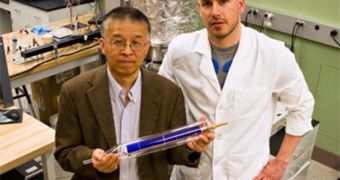The most abundant source of renewable energy has always been the Sun, but technologies available to us today make it impossible to convert its heat and light into electricity in an efficient manner. Now, experts develop a new approach to doing so, that is 8 times more effective than any others.
According to the team behind the study, the method is a bit unorthodox, but much more efficient than anything else in use today. Oddly enough, it may even be cheaper to employ than it is to buy the most advanced, thin-film solar panels today.
In a paper published online in the May 1 issue of the top journal Nature Materials, experts at the Massachusetts Institute of Technology (MIT) say that their instrument is 800 percent more efficient than any other solar thermoelectric device.
The main thing that separates the machine from others like it, investigators say, is the fact that it produces a temperature difference of about 200 degrees Celsius between its interior and exterior. This difference is then harnessed to produce electricity.
The research team that developed the technology was led by the director of the MIT Pappalardo Micro and Nano Engineering Laboratories, Gang Chen. The expert is also the Carl Richard Soderberg Professor in Power Engineering at the Institute.
University of Texas in Austin associate professor of mechanical engineering Li Shi explains that the level of conversion efficiency the MIT team obtained from the get-go – between 4 and 6 percent – is already comparable to that of commercially-available solar cells.
“With the use of other or new thermoelectric materials that can operate at a higher temperature, the efficiency may be improved further to be competitive with that for state-of-the-art amorphous silicon solar cells,” he explains further.
“This can potentially provide a different approach to realizing the $1-per-watt goal for solar-electricity conversion,” Li Shi believes. However, Gang Chen is quick to point out that the new technology is not meant to replace standard photovoltaic cells.
Rather, the new device is meant to represent a different approach to doing the same thing – which is harnessing the power of the Sun. The instrument looks pretty much like a standard solar panel, but is made up of different materials, and employs an entirely different way of harnessing sunlight and heat.
The funding required to conduct the new investigation was provided by the Solid-State Solar-Thermal Energy Conversion Center, which is a US Department of Energy (DOE) Energy Frontier Research Center.

 14 DAY TRIAL //
14 DAY TRIAL //